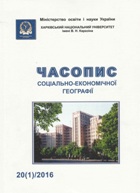Ethnogeographical processes in the ukrainian diaspora of Moldova
Abstract
Ukrainian diaspora represents the Ukrainian language, culture and customs in the countries of residence. In turn, Ukrainians of abroad requires government assistance in solving problems related to legal and material support. One way to improve state diaspora policy is researching of Ukrainian diaspora in different countries. The practical results of such researches should become the basis for decisions to Ukrainian authority.
One of the countries with numerous Ukrainian diaspora isMoldova. Compared withCanada, theUSAand theRussian Federationresearch of Ukrainian diaspora inMoldovaless attention is payed. Both countries are united by not only borders, but also history. Ukrainians in this country are the second largest ethnic group after the titular ethnic group. The numbers of Ukrainians inMoldovaare reduced through the processes of ethnic assimilation, generation change, re-emigration intoUkraine. The significant number of Ukrainian lives in the breakawayTrans-DniesterMoldavianRepublicwhere Ukrainian diaspora population decreases and integration into a numerous Russian diaspora. Ukrainians live compactly in the north, where the share of Ukrainian population exceeds 10% in some areas. There is territorial pattern of Ukrainian detected in settling: the share of Ukrainian population decreased in the “north-south” vector.
Ukrainians are not integrated in the titular ethnic group language environment. Thus, according to the census a small proportion of the Ukrainian indicated Moldovan as their native language, and that language is usually spoken. Quite common among the Ukrainian diaspora is Russian. The study founds that the share of Ukrainian who reported Ukrainian as their mother tongue and the language of communication decreases in the “north-south” direction.
Downloads
References
2. Lencyk-Pawliczko, A. (1994). Ukraine and Ukrainians throughout the World: A Demographic and Sociological Guide to the Homeland and Its Diaspora. University of Toronto Press, 509.
3. Analiticheskaya zapiska «Ob itogax perepisi naseleniya Pridnestrovskoy Moldavskoy Respubliki 2004 goda». (2006). Gosudarstvennaya sluzhba statistiki ministerstva ekonomiki PMR. Tiraspol, 200.
4. Vinnichenko, І.І. (1992). Ukraintsі v derzhavakh kolyshnioho SRSR: іstoryko-geografіchnyy narys. Zhytomyr: Lyonok, 112.
5. Stolіy, V.A. (2003). Entsiklopedіya іstorіi Ukrainy: T. 1. K.: Naukova dumka, 688.
6. Etnіchnyi sklad naselennya Moldovy za perepysom naselennya 2004 r. Avialable at: http://pop-stat.mashke.org/moldova-ethnic-loc2004.htm.
7. Etnіchnyy sklad naselennya Prydnіstrovskoi Moldovskoi Respublіky za perepysom naselennya 2004 r. Avialable at: http://pop-stat.mashke.org/pmr-ethnic-loc2004.htm.
8. Zaimova, L. Ukraintsі v kulturі Moldovi. Tematychna bіblіografіya. Avialable at: http://hasdeu.md/ro/ebibl/ucraina%20a5.pdf.
9. Zastavnyi, F.D. (1992). Skhіdna ukrainska dіaspora. Lvіv: Svіt, 176.
10. Kabuzan, V.M. (2006). Ukraintsy v mire: dinamika chislennosti i rasseleniya. 20-e gody XVIII veka – 1989 god: formirovanie etnicheskikh i politicheskikh granits ukrainskogo etnosa. In-t ros. istorii RAN. M.: Nauka, 658.
11. Melnychuk, G. Ukraina – Moldova: problemy ta perspektyvy dvostoronnіkh vіdnosyn (90-tі rr. XX st. – pochatok XXІ st.). Avialable at: http://buktolerance.com.ua/?page_id=10.
12. Ukrainska dіaspora v Respublіtsі Moldova. Avialable at: http://cheremosh30.org.ua/ukraina-sysidy.html.




